Exploring the Driving Factors of Land Use Change and Spatial Distribution in Coastal Cities: A Case Study of Xiamen City
Abstract
1. Introduction
2. Methodology
2.1. Study Area, Hypothesis, Data Source and Processing
2.1.1. Study Area
2.1.2. Observation and Research Hypothesis
- (1)
- New built-up land expands outward from the original built-up areas. Since the reform and opening-up period, such a distribution may be influenced by the urbanization and industrialization of district centers, along with the structure of port economies and industrial zones [38,39]. Consequently, factors such as the distances to district centers and town centers were selected as possible driving factors for analysis.
- (2)
- The process of urbanization and industrialization has led to the construction of an extensive road network. The expansion and connectivity of the road network have further influenced surrounding land use changes, facilitating the conversion of farmland into built-up land [40,41]. Thus, the distance to the road network was chosen as a possible driving factor.
- (3)
- Considering that the district centers are predominantly located in areas not far from the coastline and that the expansion of built-up land and the loss of farmland primarily occur in coastal regions, while forested areas are found further from the coast, the distance to the coastline was selected as a possible driving factor.
- (4)
- Finally, the terrain elevation and slope likely play a significant role [42,43]. The topography in Xiamen differs from the northwest to the southeast, with higher elevations in the northwest, which is the main area for grasslands and forests [39]. Moving southeast from the low- to mid-elevation mountains and high hills of the northwest, there are low hills, marine plains, and tidal flats. The farmland in low and flat areas has been developed into built-up land previously [43]. Hence, elevation and slope were chosen as possible driving factors.
2.1.3. Data Source and Data Processing
2.2. Methods
2.2.1. Logistic Regression
2.2.2. Dyna-CLUE Model
- (1)
- Restricted Area: The regional constraint file delineates the administrative boundaries of the study area, with large water bodies designated as restricted areas.
- (2)
- Conversion Rules of Land Use Type: Based on the historical characteristics of land use in the study area for the three phases (1989–2000, 2000–2010, and 2010–2018), the conversion flexibility coefficients for farmland, grassland, forest land, built-up land, and watershed were established [31,48], as well as the transition matrix for simulations (Figure 3). Logistic regression was employed to derive the regression coefficients for the distribution of each land use type relative to the driving factors, thus defining the distribution rules for each land use type.
- (3)
- Model Validation: First, the Relative Operating Characteristic (ROC) method was used to validate the logistic regression results [45]. The calculated Area Under the Curve (AUC) of ROC ranges from 0.5 to 1; when the AUC value exceeds 0.7, the selected driving factors are considered to have a good explanatory ability for the land use types and this suggests a better prediction ability and accuracy [45]. Second, the Dyna-CLUE simulation results were validated by spatially overlaying the spatial distribution of simulated land use with the actual observed land use map and calculating the Kappa coefficient to assess the simulation accuracy [49]. A Kappa coefficient of 75% or higher suggests better similarity [50,51,52].
3. Results
3.1. Logistic Regression Results and ROC Test at Each Time Point
3.1.1. Logistic Regression in 1989
3.1.2. Logistic Regression in 2000
3.1.3. Logistic Regression in 2010
3.2. Simulation Results and Accuracy Testing for Each Period
3.2.1. Simulation in the Period of 1989–2000
3.2.2. Simulation in the Period of 2000–2010
3.2.3. Simulation in the Period of 2010–2018
4. Discussion
4.1. Land Use Changes, Coastline, and Accuracy
4.2. Rapid Development and Ecological Issues
4.3. Recommendations for Land Use Management and Urban Planning
4.4. Limitations
5. Conclusions
Author Contributions
Funding
Institutional Review Board Statement
Informed Consent Statement
Data Availability Statement
Acknowledgments
Conflicts of Interest
References
- Foley Jonathan, A.; DeFries, R.; Asner Gregory, P.; Barford, C.; Bonan, G.; Carpenter Stephen, R.; Chapin, F.S.; Coe Michael, T.; Daily Gretchen, C.; Gibbs Holly, K.; et al. Global consequences of land use. Science 2005, 309, 570–574. [Google Scholar] [CrossRef] [PubMed]
- Pocewicz, A.; Nielsen-Pincus, M.; Goldberg, C.S.; Johnson, M.H.; Morgan, P.; Force, J.E.; Waits, L.P.; Vierling, L. Predicting land use change: Comparison of models based on landowner surveys and historical land cover trends. Landsc. Ecol. 2008, 23, 195–210. [Google Scholar] [CrossRef]
- Liu, Y.; Fang, F.; Li, Y. Key issues of land use in China and implications for policy making. Land Use Policy 2014, 40, 6–12. [Google Scholar] [CrossRef]
- Vizzari, M.; Hilal, M.; Sigura, M.; Antognelli, S.; Joly, D. Urban-rural-natural gradient analysis with CORINE data: An application to the metropolitan France. Landsc. Urban Plan. 2018, 171, 18–29. [Google Scholar] [CrossRef]
- Ojima, D.; Lavorel, S.; Graumlich, L.; Moran, E. Terrestrial human-environment systems: The future of land research in IGBP II. IGBP Glob. Change Newsl. 2002, 50, 31–34. [Google Scholar]
- Turner, B.L., II. Toward integrated land-change science: Advances in 1.5 decades of sustained international research on land-use and land-cover change. In Proceedings of the Challenges of a Changing Earth, Global Change Open Science Conference, Amsterdam, The Netherlands, 10–13 July 2001; Springer: Berlin/Heidelberg, Germany, 2001; pp. 21–26. [Google Scholar]
- White, R.; Engelen, G.; Uljee, I. The use of constrained cellular automata for high resolution modeling of urban land-use dynamics. Environ. Plan. B Plan. Des. 1997, 24, 323–343. [Google Scholar] [CrossRef]
- Gollnow, F.; Göpel, J.; deBarros Viana Hissa, L.; Schaldach, R.; Lakes, T. Scenarios of land-use change in a deforestation corridor in the Brazilian Amazon: Combining two scales of analysis. Reg. Environ. Change 2018, 18, 143–159. [Google Scholar] [CrossRef]
- Marsh, G.P. Man and Nature: Or Physical Geography as Modified by Human Action; Charles Scribner: New York, NY, USA, 1869. [Google Scholar]
- Sharifi, M.A.; van Keulen, H.; van de Toorn, W. Collaborative integrated planning and decision support system for land use planning and policy analysis. Gene 2002, 145, 69–73. [Google Scholar]
- Agarwal, C.; Green, G.M.; Grove, J.M.; Evans, T.P.; Schweik, C.M. A Review and Assessment of Land-Use Change Models: Dynamics of Space, Time and Human Choice; US Department of Agriculture, Forest Service, Northeastern Research Station: Newton Square, PA, USA, 2002.
- Simon, R. Swaffield.; John, R. Investigation of attitudes towards the effects of land use change using image editing and Q sort method. Landsc. Urban Plan. 1996, 35, 213–230. [Google Scholar]
- Hale, I.L.; Wollheim, W.M.; Smith, R.G.; Asbjornsen, H.; Brito, A.F.; Broders, K.; Grandy, A.S.; Rowe, R. A Scale-Explicit Framework for Conceptualizing the Environmental Impacts of Agricultural Land Use Changes. Sustainability 2014, 6, 8432–8451. [Google Scholar] [CrossRef]
- Salazar, E.; Henríquez, C.; Sliuzas, R.; Qüense, J. Evaluating spatial scenarios for sustainable development in Quito, Ecuador. ISPRS Int. J. Geo-Inf. 2020, 9, 141. [Google Scholar] [CrossRef]
- Rounsevell, M.D.; Pedroli, B.; Erb, K.-H.; Gramberger, M.; Busck, A.G.; Haberl, H.; Kristensen, S.; Kuemmerle, T.; Lavorel, S.; Lindner, M. Challenges for land system science. Land Use Policy 2012, 29, 899–910. [Google Scholar] [CrossRef]
- Rong, T.; Zhang, P.; Jing, W.; Zhang, Y.; Li, Y.; Yang, D.; Yang, J.; Chang, H.; Ge, L. Carbon Dioxide Emissions and Their Driving Forces of Land Use Change Based on Economic Contributive Coefficient (ECC) and Ecological Support Coefficient (ESC) in the Lower Yellow River Region (1995–2018). Energies 2020, 13, 2600. [Google Scholar] [CrossRef]
- Xu, S.; Cheng, Q. Driving forces of land use change in the Tiexi old industrial relocation area, Shenyang, China. Int. J. Environ. Sci. Technol. 2022, 19, 10999–11012. [Google Scholar] [CrossRef]
- Derakhshan-Babaei, F.; Nosrati, K.; Mirghaed, F.A.; Egli, M. The interrelation between landform, land-use, erosion and soil quality in the Kan catchment of the Tehran province, central Iran. Catena 2021, 204, 105412. [Google Scholar] [CrossRef]
- Yuen, K.W.; Hanh, T.T.; Quynh, V.D.; Switzer, A.D.; Teng, P.; Lee, H. Interacting effects of land-use change and natural hazards on rice agriculture in the Mekong and Red River deltas in Vietnam. Nat. Hazards Earth Syst. Sci. 2021, 21, 1473–1493. [Google Scholar] [CrossRef]
- Lü, D.; Gao, G.; Lü, Y.; Ren, Y.; Fu, B. An effective accuracy assessment indicator for credible land use change modeling: Insights from hypothetical and real landscape analyses. Ecol. Indic. 2020, 117, 106552. [Google Scholar] [CrossRef]
- Liao, G.; He, P.; Gao, X.; Lin, Z.; Huang, C.; Zhou, W.; Deng, Q.; Xu, C.; Deng, L. Land use optimization of rural production–living–ecological space at different scales based on the BP–ANN and CLUE–S models. Ecol. Indic. 2022, 137, 108710. [Google Scholar] [CrossRef]
- Zhang, P.; Liu, Y.; Pan, Y.; Yu, Z. Land use pattern optimization based on clue-s and swat models for agricultural non-point source pollution control. Math. Comput. Model. 2013, 58, 588–595. [Google Scholar] [CrossRef]
- Long, Y.; Han, H.; Tu, Y.; Shu, X. Evaluating the effectiveness of urban growth boundaries using human mobility and activity records. Cities 2015, 46, 76–84. [Google Scholar] [CrossRef]
- Wei Y, D.; Ye X, Y. Urbanization, urban land expansion and environmental change in China. Stoch. Environ. Res. Risk Assess. 2014, 28, 757–765. [Google Scholar] [CrossRef]
- Yue W, Z.; Fan P, L.; Wei Y, D.; Qi J, G. Economic development, urban expansion, and sustainable development in Shanghai. Stoch. Environ. Res. Risk Assess. 2014, 28, 783–799. [Google Scholar] [CrossRef]
- Zhang, T. Using Satellite Imagery to Determine Spatiotemporal Patterns of Built-Up Land Use in Relation to the Coastline: An Example from Xiamen, China. J. Coast. Res. 2023, 39, 103–113. [Google Scholar] [CrossRef]
- Lima, M.L.; Romanelli, A.; Massone, H.E. Assessing groundwater pollution hazard changes under different socio-economic and environmental scenarios in an agricultural watershed. Sci. Total Environ. 2015, 530–531, 333–346. [Google Scholar] [CrossRef]
- Satiprasad, S.; Indrani, S.; Anirban, D.; Anupam, D.; Pulakesh, D.; Amlanjyoti, K. Future scenarios of land-use suitability modeling for agricultural sustainability in a river basin. J. Clean. Prod. 2018, 205 Pt 1, 313–328. [Google Scholar]
- Yang, Y.; Bao, W.; Liu, Y. Scenario simulation of land system change in the beijing-tianjin-hebei region. Land Use Policy 2020, 96, 104677. [Google Scholar] [CrossRef]
- Hu, M.; Wang, Y.; Xia, B.; Jiao, M.; Huang, G. How to balance ecosystem services and economic benefits?—A case study in the pearl river delta, China. J. Environ. Manag. 2020, 271, 110917. [Google Scholar] [CrossRef]
- Gong, J.; Hu, Z.; Chen, W.; Liu, Y.; Wang, J. Urban expansion dynamics and modes in metropolitan guangzhou, china. Land Use Policy 2018, 72, 100–109. [Google Scholar] [CrossRef]
- Liao, J.; Shao, G.; Wang, C.; Tang, L.; Qiu, Q. Urban sprawl scenario simulations based on cellular automata and ordered weighted averaging ecological constraints. Ecol. Indic. 2019, 107, 105572. [Google Scholar] [CrossRef]
- Liao, J.; Tang, L.; Shao, G.; Su, X.; Chen, D.; Xu, T. Incorporation of extended neighborhood mechanisms and its impact on urban land-use cellular automata simulations. Environ. Model. Softw. 2016, 75, 163–175. [Google Scholar] [CrossRef]
- Xiamen Bureau of Statistics (XBS). 2023. Available online: http://tjj.xm.gov.cn/tjzl/tjsj/tqnj/ (accessed on 1 October 2024).
- National Bureau of Statistics of China (NBSC). 2023. Available online: https://data.stats.gov.cn/ (accessed on 1 October 2024).
- Lambin E, F.; Geist H, J.; Lepers, E. Dynamics of land-use and land-cover change in tropical regions. Annu. Rev. Environ. Resour. 2003, 28, 205–241. [Google Scholar] [CrossRef]
- Turner, B.; Skole, D.; Sanderson, S.; Fischer, G.; Fresco, L.; Leemans, R. Land-Use and Land-Cover Change: Science/Research Plan; IGBP Report No. 35/HDP Report No. 7; IGBP: Stockholm/Sweden/Geneva, Switzerland, 1995. [Google Scholar]
- Lawler, J.J.; Lewis, D.J.; Nelson, E.; Plantinga, A.J.; Polasky, S.; Withey, J.C.; Helmers, D.P.; Martinuzzi, S.; Pennington, D.; Radeloff, V.C. Projected land-use change impacts on ecosystem services in the United States. Proc. Natl. Acad. Sci. USA 2014, 111, 7492–7497. [Google Scholar] [CrossRef] [PubMed]
- Waiyasusri, K.; Yumuang, S.; Chotpantarat, S. Monitoring and predicting land use changes in the Huai Thap Salao Watershed area, Uthaithani Province, Thailand, using the CLUE-s model. Environ. Earth Sci. 2016, 75, 533. [Google Scholar] [CrossRef]
- Jansen, L.J.M.; Bagnoli, M.; Focacci, M. Analysis of land-cover/use change dynamics in Manica Province in Mozambique in a period of transition (1990–2004). For. Ecol. Manag. 2008, 254, 308–326. [Google Scholar] [CrossRef]
- Liu, J.; Zhang, Z.; Xu, X.; Kuang, W.; Zhou, W.; Zhang, S.; Li, R.; Yan, C.; Yu, D.; Wu, S.; et al. Spatial patterns and driving forces of land use change in China in the early 21st century. Acta Geograph. Sin. 2009, 64, 1411–1420. [Google Scholar] [CrossRef]
- Wischmeier, W.H.; Smith, D.D. Predicting Rainfall Erosion Losses: A Guide to Conservation Planning; Department of Agriculture, Science and Education Administration: Washington, DC, USA, 1978. [Google Scholar]
- Du, X.; Jin, X.; Yang, X.; Yang, X.; Zhou, Y. Spatial pattern of land use change and its driving force in Jiangsu province. Int. J. Environ. Res. Public Health 2014, 11, 3215–3232. [Google Scholar] [CrossRef]
- Verburg, P.H.; Alexander, P.; Evans, T.; Magliocca, N.R.; Malek, Z.; Rounsevell, M.D.; van Vliet, J. Beyond land cover change: Towards a new generation of land use models. Curr. Opin. Environ. Sustain. 2019, 38, 77–85. [Google Scholar] [CrossRef]
- Pontius, R.G.J.; Boersma, W.; Castella, J.C.; Clarke, K.; Nijs, T.D.; Dietzel, C.; Duan, Z.; Fotsing, E.; Goldstein, N.; Kok, K. Comparing the input, output, and validation maps for several models of land change. Ann. Reg. Sci. 2008, 42, 11–37. [Google Scholar] [CrossRef]
- Edition, S. Applied logistic regression analysis. Technometrics 2010, 38, 184–186. [Google Scholar]
- Gobin, A.; Campling, P.; Feyen, J. Logistic modelling to derive agricultural land use determinants: A case study from southeastern Nigeria. Agric. Ecosyst. Environ. 2002, 89, 213–228. [Google Scholar] [CrossRef]
- Batisani, N.; Yarnal, B. Urban expansion in Centre County, Pennsylvania: Spatial dynamics and landscape transformations. Appl. Geogr. 2009, 29, 235–249. [Google Scholar] [CrossRef]
- Ren, Y.; Lü, Y.; Comber, A.; Fu, B.; Harris, P.; Wu, L. Spatially explicit simulation of land use/land cover changes: Current coverage and future prospects. Earth-Sci. Rev. 2019, 190, 398–415. [Google Scholar] [CrossRef]
- Mas, J.-F.; Kolb, M.; Paegelow, M.; Camacho Olmedo, M.T.; Houet, T. Inductive pattern-based land use/cover change models: A comparison of four software packages. Environ. Model. Softw. 2014, 51, 94–111. [Google Scholar] [CrossRef]
- Zare, M.; Nazari Samani, A.A.; Mohammady, M.; Salmani, H.; Bazrafshan, J. Investigating effects of land use change scenarios on soil erosion using CLUE-s and RUSLE models. Int. J. Environ. Sci. Technol. 2017, 14, 1905–1918. [Google Scholar] [CrossRef]
- Zheng, F.; Hu, Y. Assessing temporal-spatial land use simulation effects with CLUES and Markov-CA models in Beijing. Environ. Sci. Pollut. Res. 2018, 25, 32231–32245. [Google Scholar] [CrossRef]
- Zhang, T.; Qu, Y.; Liu, Y.; Yan, G.; Foliente, G. Spatiotemporal Response of Ecosystem Service Values to Land Use Change in Xiamen, China. Sustainability 2022, 14, 12532. [Google Scholar] [CrossRef]
- Zhang, T.; Sun, W.; Xiao, J.; Yan, G. The impact of land use change on food security under the background of rapid urbanization—A case study of Xiamen city. Environ. Res. Commun. 2024, 6, 105006. [Google Scholar] [CrossRef]
- Zhang, T.; Tang, L.; Wen, Y.; Wang, C. The development stage of Xiamen city and related environment evolution. J. Environ. Eng. Landsc. Manag. 2022, 30, 350–362. [Google Scholar] [CrossRef]
- Zhao, J.; Song, Y.; Tang, L.; Shi, L.; Shao, G. China’s cities need to grow in a more compact way. Environ. Sci. Technol. 2011, 45, 8607–8608. [Google Scholar] [CrossRef] [PubMed]
- Daunt, A.; Inostroza, L.; Hersperger, A.M. The role of spatial planning in land change: An assessment of urban planning and nature conservation efficiency at the southeastern coast of Brazil. Land Use Policy 2021, 111, 105771. [Google Scholar] [CrossRef]
- Department of Economic and Social Affairs (UNDESA). United Nations. Population Division. 2019. Available online: https://population.un.org/wup/assets/WUP2018-Report.pdf (accessed on 1 October 2024).
- Cotter, M.; Berkhoff, K.; Gibreel, T.; Ghorbani, A.; Golbon, R.; Nuppenau, E.A.; Sauerborn, J. Designing a sustainable land use scenario based on a combination of ecological assessments and economic optimization. Ecol. Indicat. 2014, 36, 779–787. [Google Scholar] [CrossRef]
- Qi, X.; Fu, Y.; Wang, R.Y.; Ng, C.N.; Dang, H.; He, Y. Improving the sustainability of agricultural land use: An integrated framework for the conflict between food security and environmental deterioration. Appl. Geogr. 2018, 90, 214–223. [Google Scholar] [CrossRef]
- Yao, J.; Zhang, X.; Murray, A.T. Spatial optimization for land-use allocation: Accounting for sustainability concerns. Int. Reg. Sci. Rev. 2017, 41, 579–600. [Google Scholar] [CrossRef]

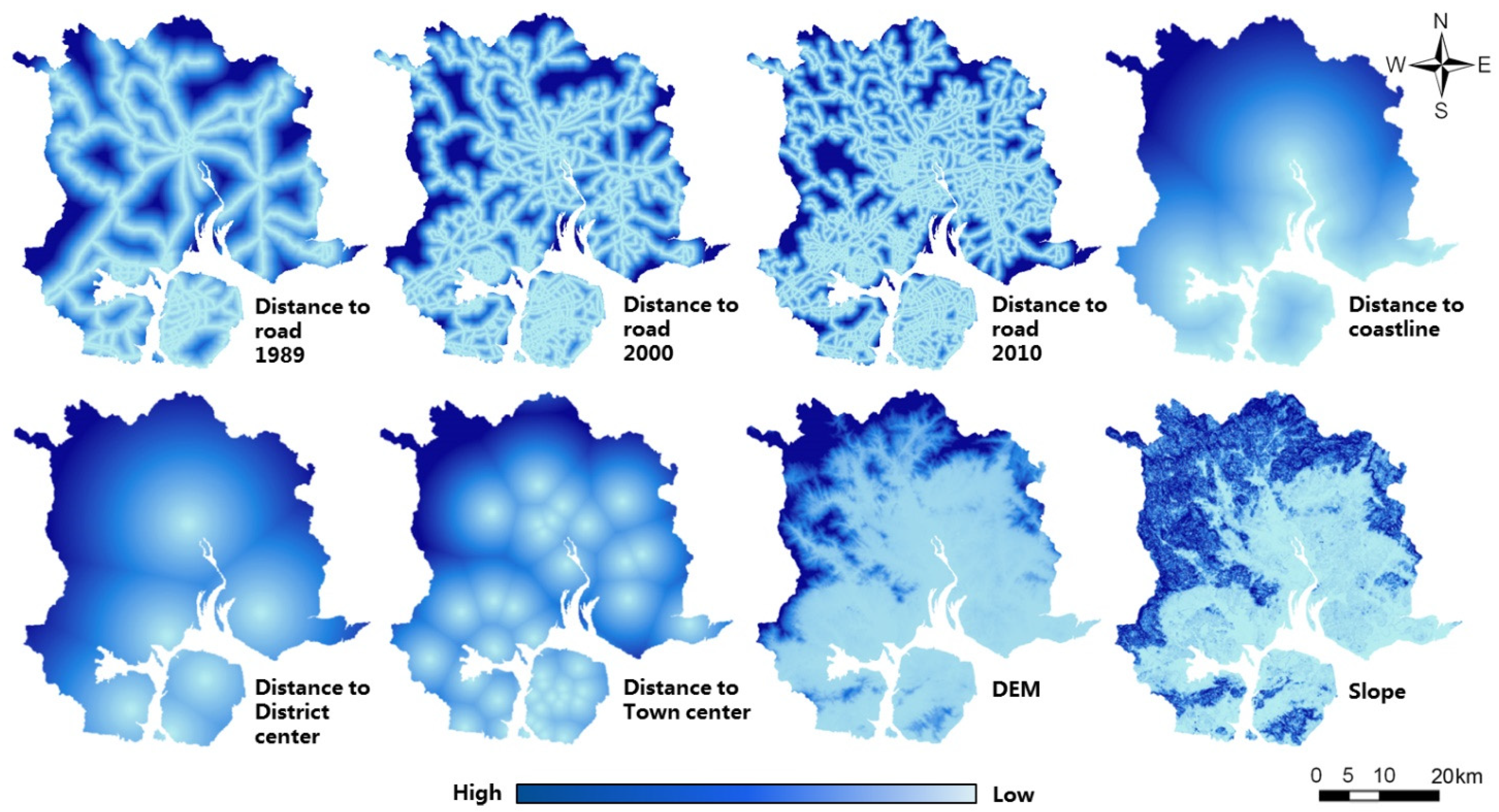

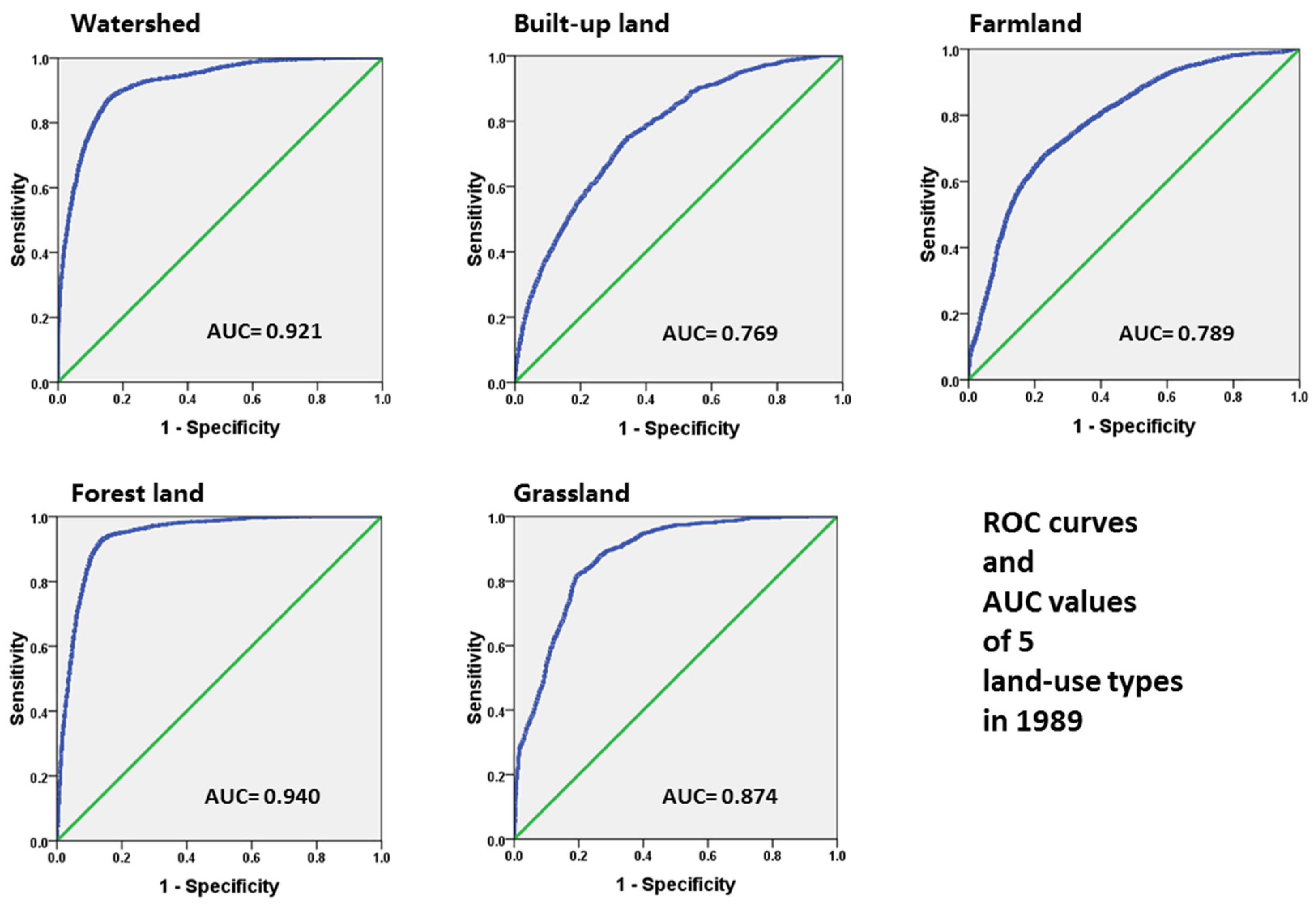

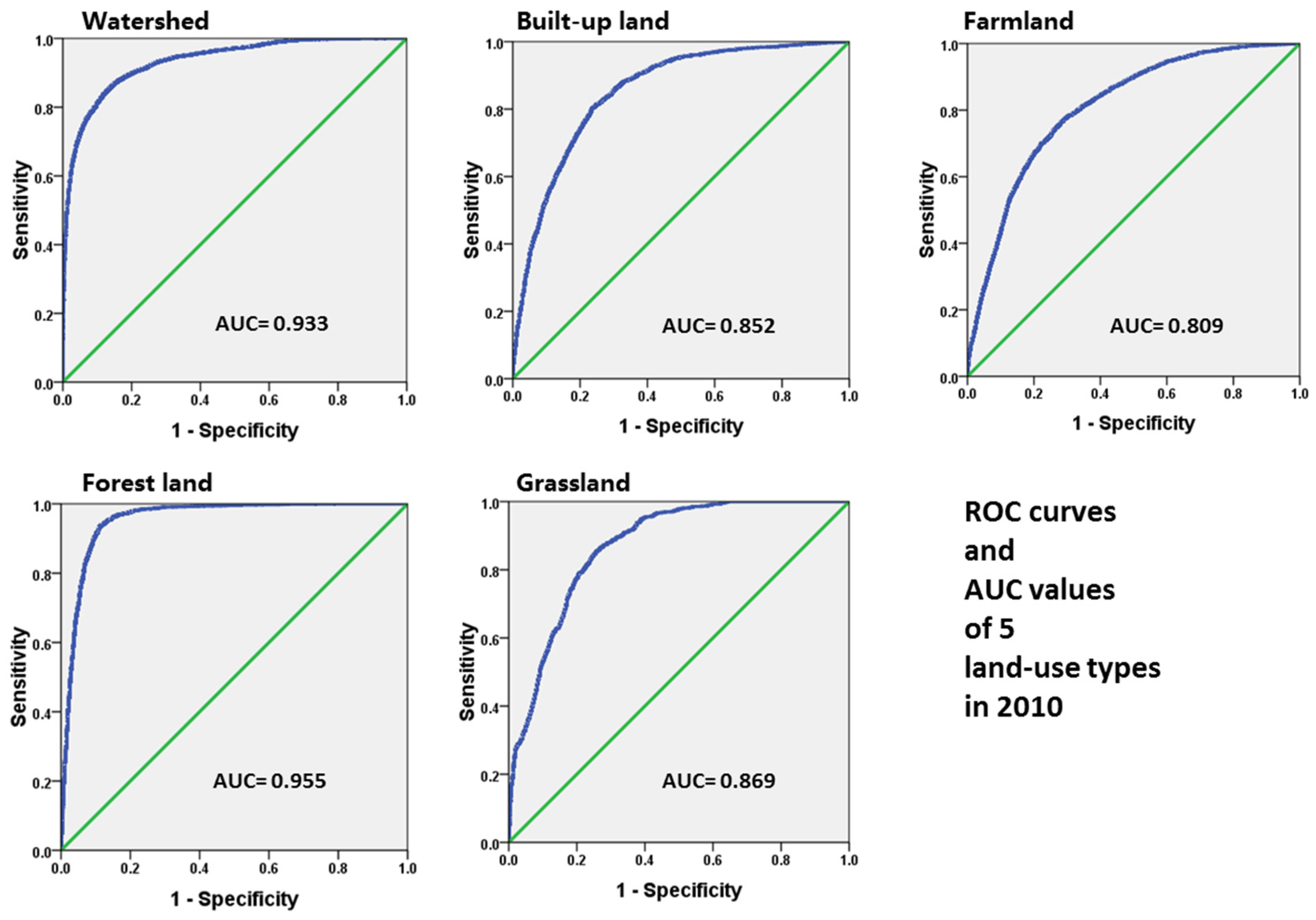
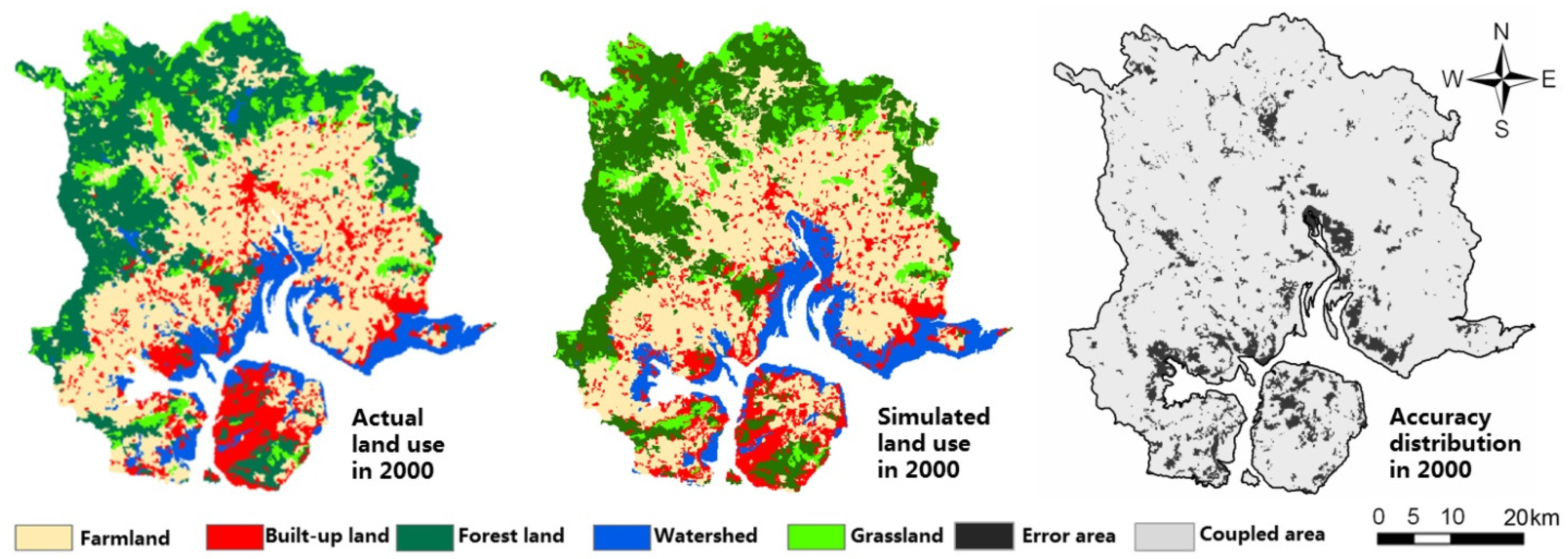
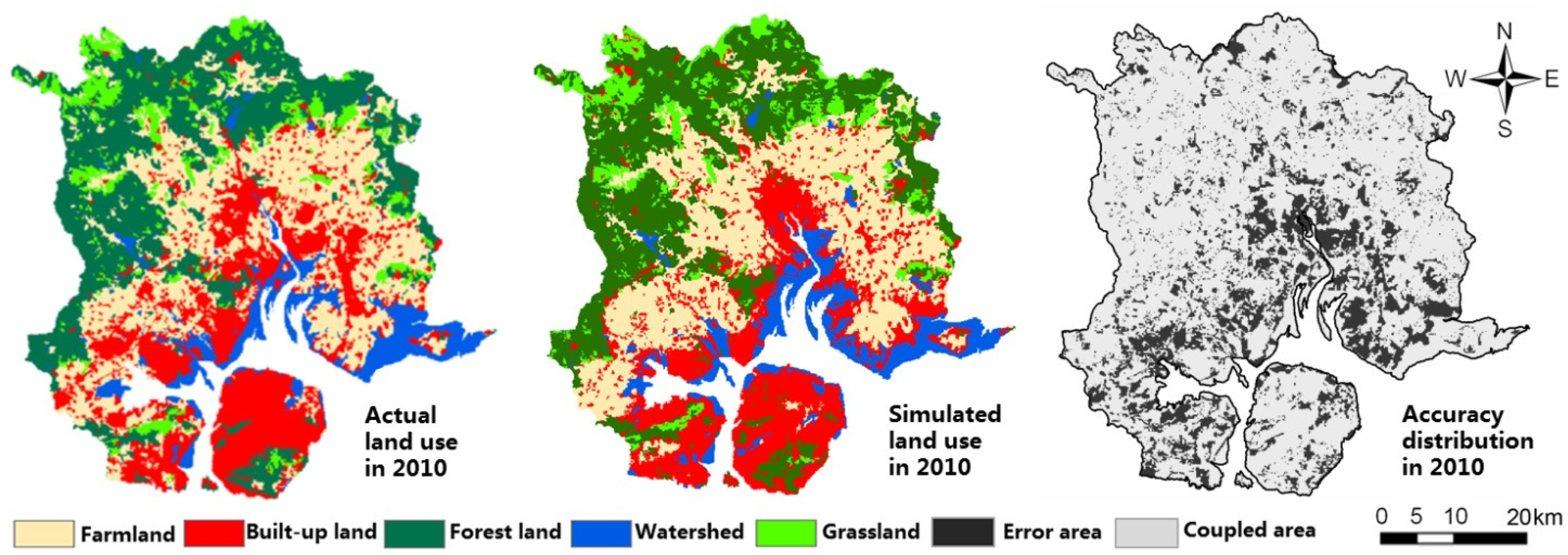
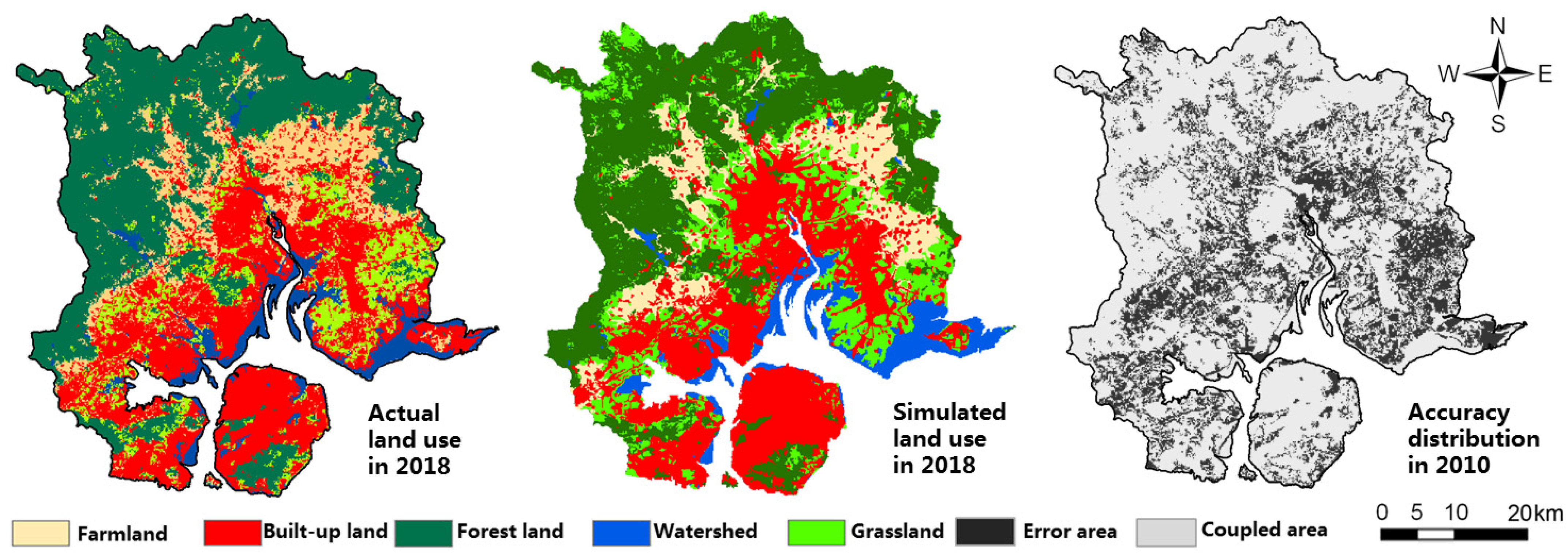
| 1989 | Watershed | Built-Up Land | Farmland | Forest Land | Grassland |
|---|---|---|---|---|---|
| DR | 3.252 | −5.061 | −1.49 | 1.171 | |
| DC | −10.493 | 3.004 | 9.654 | 2.998 | 7.403 |
| DDC | 1.984 | −2.825 | −1.425 | 1.612 | −3.857 |
| DTC | 6.207 | −4.94 | −5.023 | −2.21 | −2.534 |
| Dem | −3.526 | −6.322 | −8.67 | 2.879 | |
| Slope | −15.559 | 1.228 | −2.443 | 0.789 | |
| AUC | 0.921 | 0.769 | 0.789 | 0.94 | 0.874 |
| 2000 | Watershed | Built-Up Land | Farmland | Forest Land | Grassland |
|---|---|---|---|---|---|
| DR | 10.029 | −10.51 | −6.211 | 1.454 | |
| DC | −9.23 | 2.791 | 8.516 | 4.165 | 6.6 |
| DDC | 1.201 | −2.569 | 0.896 | −3.273 | |
| DTC | 5.137 | −6.678 | −3.497 | −3.3 | −2.29 |
| Dem | −10.456 | −3.715 | −10.138 | 0.616 | 3.792 |
| Slope | −13.255 | 1.409 | −1.355 | 8.648 | 0.719 |
| AUC | 0.927 | 0.807 | 0.801 | 0.945 | 0.883 |
| 2010 | Watershed | Built-Up Land | Farmland | Forest Land | Grassland |
|---|---|---|---|---|---|
| DR | 15.079 | −19.224 | −7.608 | 0.841 | |
| DC | −6.408 | 8.093 | 3.078 | 8.388 | |
| DDC | 1.599 | −2.412 | 0.591 | 1.521 | −4.603 |
| DTC | 9.235 | −6.471 | −4.648 | −3.851 | −2.409 |
| Dem | −13.215 | −8.11 | 2.513 | 2.597 | |
| Slope | −13.53 | −1.809 | 9.418 | 0.962 | |
| AUC | 0.933 | 0.852 | 0.809 | 0.955 | 0.869 |
| Land Use | Watershed | Built-Up Land | Farmland | Forest Land | Grassland | Total Cells (%) |
|---|---|---|---|---|---|---|
| Actual cells in 2000 | 15,261 | 21,649 | 62,407 | 46,762 | 15,203 | 161,282 (100%) |
| Correct cells in simulated (2000) | 11,412 | 18,030 | 55,606 | 45,309 | 14,969 | 145,326 (90.1%) |
| Actual cells in 2010 | 13,539 | 40,240 | 47,288 | 47,186 | 13,029 | 161,282 (100%) |
| Correct cells in simulated (2010) | 9882 | 25,924 | 36,191 | 44,189 | 10,731 | 126,917 (78.7%) |
| Actual cells in 2018 | 10,586 | 49,072 | 17,779 | 57,834 | 26,011 | 161,282 (100%) |
| Correct cells in simulated (2018) | 7411 | 33,349 | 7620 | 48,227 | 7824 | 104,431 (64.8%) |
Disclaimer/Publisher’s Note: The statements, opinions and data contained in all publications are solely those of the individual author(s) and contributor(s) and not of MDPI and/or the editor(s). MDPI and/or the editor(s) disclaim responsibility for any injury to people or property resulting from any ideas, methods, instructions or products referred to in the content. |
© 2025 by the authors. Licensee MDPI, Basel, Switzerland. This article is an open access article distributed under the terms and conditions of the Creative Commons Attribution (CC BY) license (https://creativecommons.org/licenses/by/4.0/).
Share and Cite
Zhang, T.; Foliente, G.; Xiao, J.; Tang, L. Exploring the Driving Factors of Land Use Change and Spatial Distribution in Coastal Cities: A Case Study of Xiamen City. Sustainability 2025, 17, 941. https://doi.org/10.3390/su17030941
Zhang T, Foliente G, Xiao J, Tang L. Exploring the Driving Factors of Land Use Change and Spatial Distribution in Coastal Cities: A Case Study of Xiamen City. Sustainability. 2025; 17(3):941. https://doi.org/10.3390/su17030941
Chicago/Turabian StyleZhang, Tianhai, Greg Foliente, Jiangtao Xiao, and Lina Tang. 2025. "Exploring the Driving Factors of Land Use Change and Spatial Distribution in Coastal Cities: A Case Study of Xiamen City" Sustainability 17, no. 3: 941. https://doi.org/10.3390/su17030941
APA StyleZhang, T., Foliente, G., Xiao, J., & Tang, L. (2025). Exploring the Driving Factors of Land Use Change and Spatial Distribution in Coastal Cities: A Case Study of Xiamen City. Sustainability, 17(3), 941. https://doi.org/10.3390/su17030941








